This is a page for descriptions and my photos of some of the insects and arachnids I've seen. This page will expand as I find and photograph more of the little invertebrates. There are many that I'm not yet able to identify, but when I am, I'll add them here as well. I include here the common names as well as the scientific names in parentheses for the species, since many species have many common names or share the same name as others.
Note: Previously, there were only insects and arachnids found in my area (mainly my backyard), but recently I've expanded it to include species from other parts of the United States (it will be noted in the descriptions if they are found outside of Southern California).
Below is a Broad-winged Katydid (Microcentrum rhombifolium). Broad-winged katydids are somewhat large and resemble leaves. They can be found in woods, parks, and neighborhoods in the southwestern and eastern United States. The one below was in the middle of the concrete at my school and refused to move out of the way, even when someone nudged it. I had to pick it up on my notebook and carry it to the bushes.
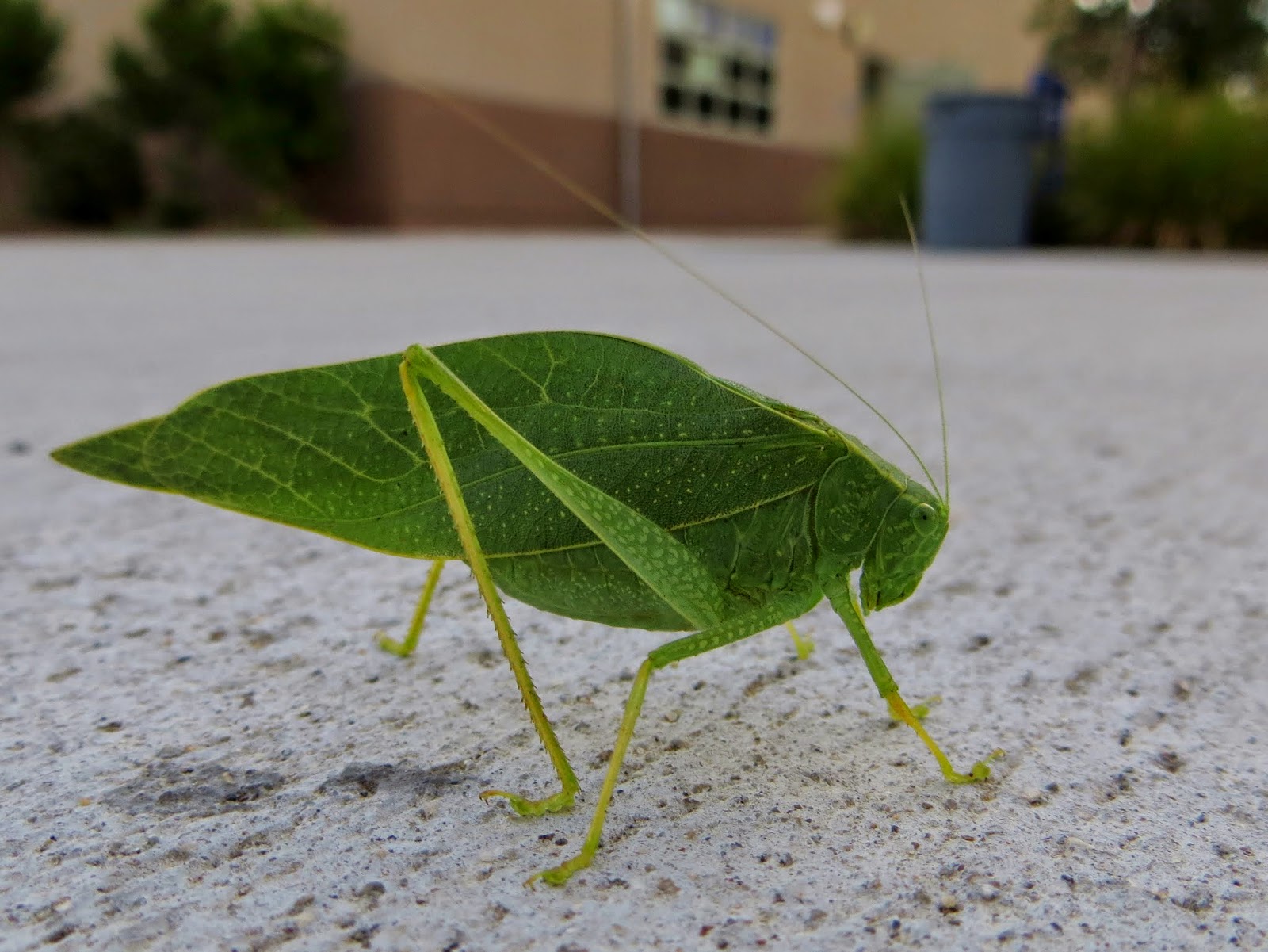 |
| Broad-winged Katydid |
Below is a Western Leaf-footed Bug (Leptoglossus clypealis). They live in the western and central United States and feed on buds, seeds, and fruits of different plants and can be pests. (Sorry the photo is terrible.)
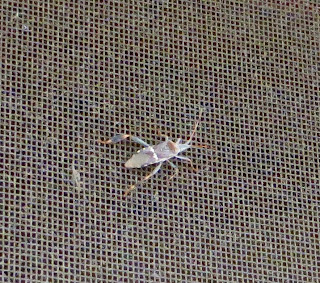 |
| Western Leaf-Footed Bug |
Below is a Bordered Plant Bug (Largus sp.). They are found throughout the United States, usually in crop fields, orchards, and gardens, as they feed on plants. Usually, they aren't too much of a problem in the garden, but large infestations can be. I've seen a couple at Cal Poly (the school is known for its college of agriculture). They can be picked up (my friend picked one up), but they will definitely start running down your arm. They look rather funny and cute when they run (they waddle).
 |
| Bordered Plant Bug |
Below are two photos of an adult and larvae Green Lacewing. (There are so many green lacewing species that I'm not able to find the exact species.) They are found throughout North America and feed on aphids and pollen. The larvae are large and strange-looking; they also bite.
 |
| Green Lacewing |
 |
| Green Lacewing |
Below is a Green Peach Beetle (Cotinis mutabilis). They are found in central and coastal California, southeastern Arizona, and Mexico. They are members of the scarab family and eat fruit and sap. They are large, very noisy beetles that will often try to fly in your face.
 |
| Green Peach Beetle |
Below are Convergent Lady Beetles (Hippodamia convergens). They are the species of lady beetles my mom bought online. They are found in southern Canada south through the United States, and down into Mexico. They eat aphids and other pests, like most other lady beetles. Their color and number of spots varies (as shown by the ones in the photo).
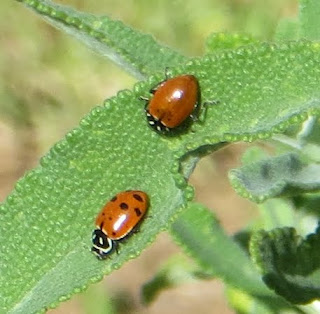 |
| Convergent Lady Beetles |
Below is a Diabolical Ironclad Beetle (Phloeodes diabolicus). I saw them occasionally at school, walking along the edges of buildings. The first one I saw, I mistook for a rock, until it began moving. They are very hard-bodied, hence the "ironclad" in their names. I'm not sure about the "diabolical" part, but it may be because it's very hard to kill them (because of they are so tough) or perhaps their appearance is somehow devilish. They are far from diabolical, however. They eat fungi and, when disturbed, tuck in their legs and play dead.
 |
| Diabolical Ironclad Beetle |
Below is a Fuller Rose Beetle (Naupactus godmanni) sitting on my dad's hand. They are in the weevil family and are often considered pests because they feed on ornamental plants and crops. They are found all over the world, due to accidental importation.
 |
| Fuller Rose Beetle |
Below are two photos of a Giant Western Crane Fly (Holorusia hespera). They are found along the western coast of the United States from Canada down through California. As their name suggests, they are very large. In fact, they are one of the largest crane fly species in the world with a length (not including legs) of about one and half inches. I've noticed that there are a couple of odd rumors about them, one being that they are giant mosquitoes, and the other being that they eat mosquitoes. Neither is true. While their larvae feed on aquatic plants, adults do not feed (they only live about a day as adults).
 |
| Giant Western Crane Fly |
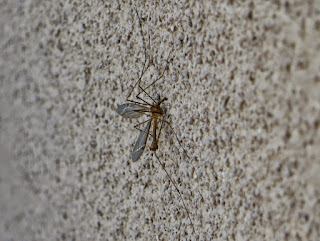 |
| Giant Western Crane Fly |
Below is a robber fly. I don't know the exact species. If I am able to find out, I'll add it here. Robber flies are rather large flies that prey on beetles, bees, wasps, and other flying insects. They act like flycatcher birds; they sit on a perch and fly out grab insects out of the air with their strong, spiny legs. Be careful around them: they do not hesitate to defend themselves and have a very painful bite.
 |
| Robber Fly |
Below is a Bee Fly (Hemipenthes sinuosa). They are found in southern Canada and most of the United States. As their name suggests, they resemble bees. They have dark bodies with yellowish hairs. Their wings have dark markings near the base. Adults feed on nectar, while the larvae are parasites of the larvae of certain sawfly species.
 |
| Bee Fly |
Below is a Mexican Cactus Fly (Copestylum mexicanum). They are shiny bluish-black, large flies; about the size of bumblebees. Larvae feed on rotting cactus while adults feed on flower nectar. At the Buena Vista Lagoon, there are a couple bushes that are covered in these flies at certain times of the year.
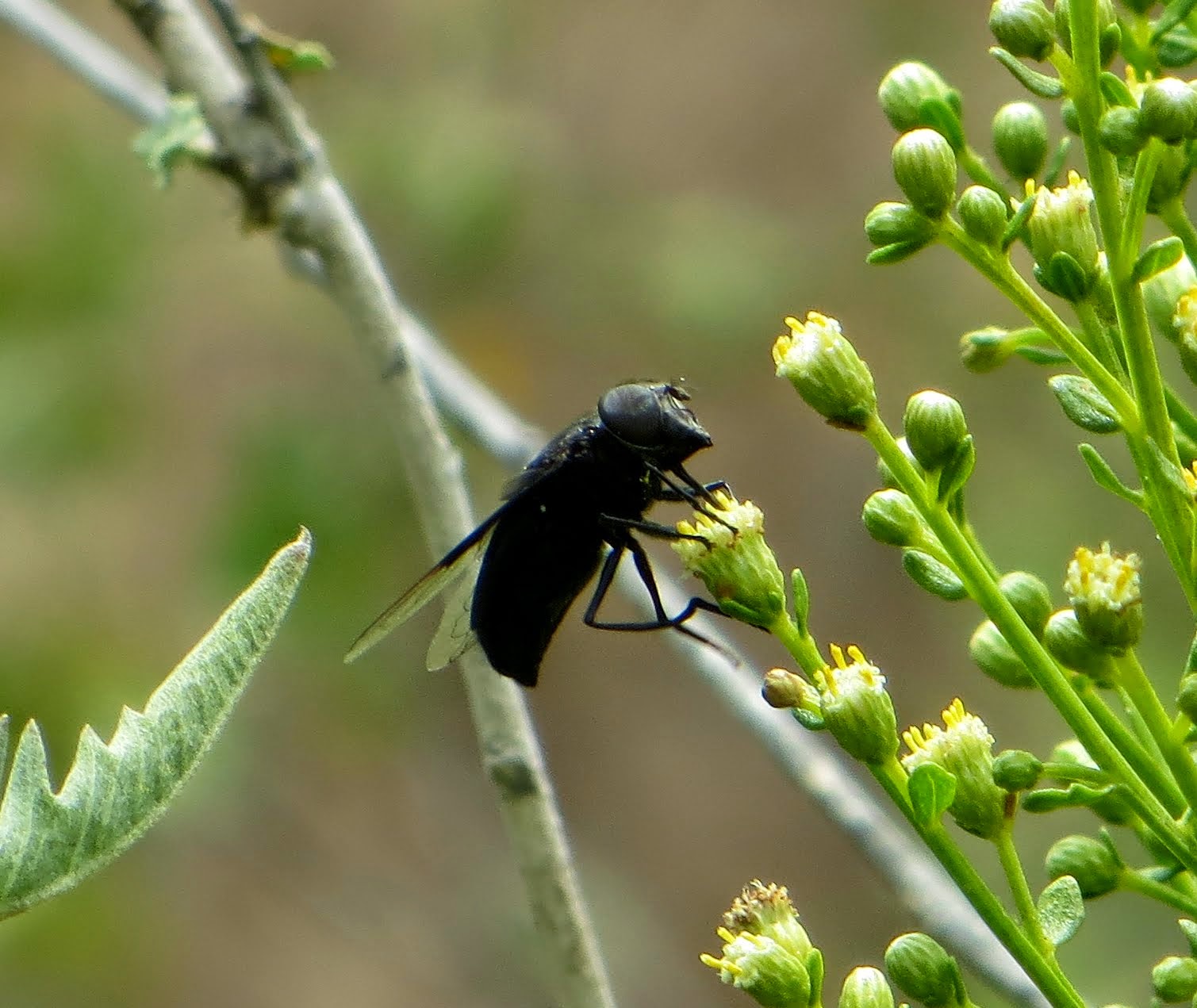 |
| Mexican Cactus Fly |
Below is a Hoverfly (Allograpta obliqua). As their name suggests, they hover. They resemble small wasps or bees, but are actually flies. They feed on aphids. They are sometimes called flower flies, since they tend to hang around near flowers, where the aphids are.
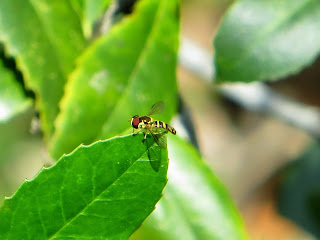 |
| Hoverfly |
Below is another species of Hoverfly (Paragus haemorrhous). They have the same coloring as some Cuckoo Bees (mostly black body, bright red abdomen), but, like the hoverfly above, they are true flies. They can be distinguished from the bees by their lack of a narrow waist, their large eyes, and their short antennae. They eat aphids and can usually be found near flowers.
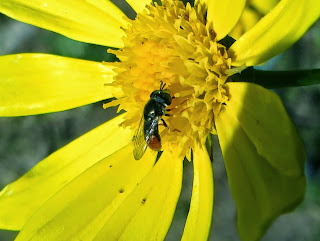 |
| Hoverfly |
Below is a Western Tiger Swallowtail (Paplio rutulus). They are found throughout much of the western United States. They are fairly large butterflies with wingspans of up to four inches. The one below was trying to land on tiny society garlic flowers, but was too heavy and kept swinging upside down.
 |
| Western Tiger Swallowtail |
Below is a Gulf Fritillary (Agraulis vanillae). They are found in the southern United States and Mexico. They are very long-winged and beautiful butterflies. They remind me of orange creamsicles with their orange and white coloring.
 |
| Gulf Fritillary |
Below is a Monarch (Danaus plexippus). They are large butterflies found in southern Canada and throughout the United States. Their caterpillars feed largely on milkweed plants. There are usually at least a few around my house. There are a lot of them at Cal Poly.
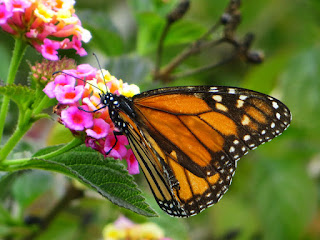 |
| Monarch |
Below is a Pearl Crescent (Phyciodes tharos). They are found in open habitats in eastern North America. They are very small.
 |
| Pearl Crescent |
Below is a Question Mark (Polygonia interrogationis). They are found in eastern North America. They are named for the small white marks that slightly resemble a question mark (visible in first photo).
 |
| Question Mark |
 |
| Question Mark |
Below is a Mourning Cloak (Nymphalis antiopa). They are found in open habitats in most of North America. They are very dark and beautiful butterflies.
 |
| Mourning Cloak |
Below is a Painted Lady (Vanessa cardui). They are found throughout North America. They are somewhat faded, but pretty, butterflies. They are very similar to Western Ladies, but their markings are less vivid.
 |
| Painted Lady |
Below is a Lorquin's Admiral (Limenitis lorquini). They are found in western North America, usually near water.
 |
| Lorquin's Admiral |
Below is a Fiery Skipper (Hylephila phyleus). They are found in California and throughout the southern United States, though they can sometimes be found farther north. Skippers can be told apart from other butterflies and moths by their distinctive shape and hooked antenna (butterflies have clubbed antenna, and moths have feathery or thread-like antenna). They are also noisy as they fly, making a little bit of a buzzing noise. They are one of the most common butterflies in my yard.
 |
| Fiery Skipper |
Below is a Carpenterworm Moth (Prionoxystus robiniae). They are large moths with wingspans of up to three inches. They are often found near hardwoods; their caterpillars bore into oaks, ashes, elms, and poplars. They are found in southern Canada and throughout the United States. When their wings are folded (such as in the photo below), their markings resemble a face.
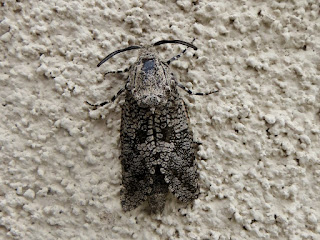 |
| Carpenterworm Moth |
Below is an Artichoke Plume Moth (Platyptilia carduidactyla). They are found throughout the United States, southern Canada, and Mexico. They are slender and hold their wings out, forming a distinctive "T" shape. Their caterpillars feed on artichokes and thistles.
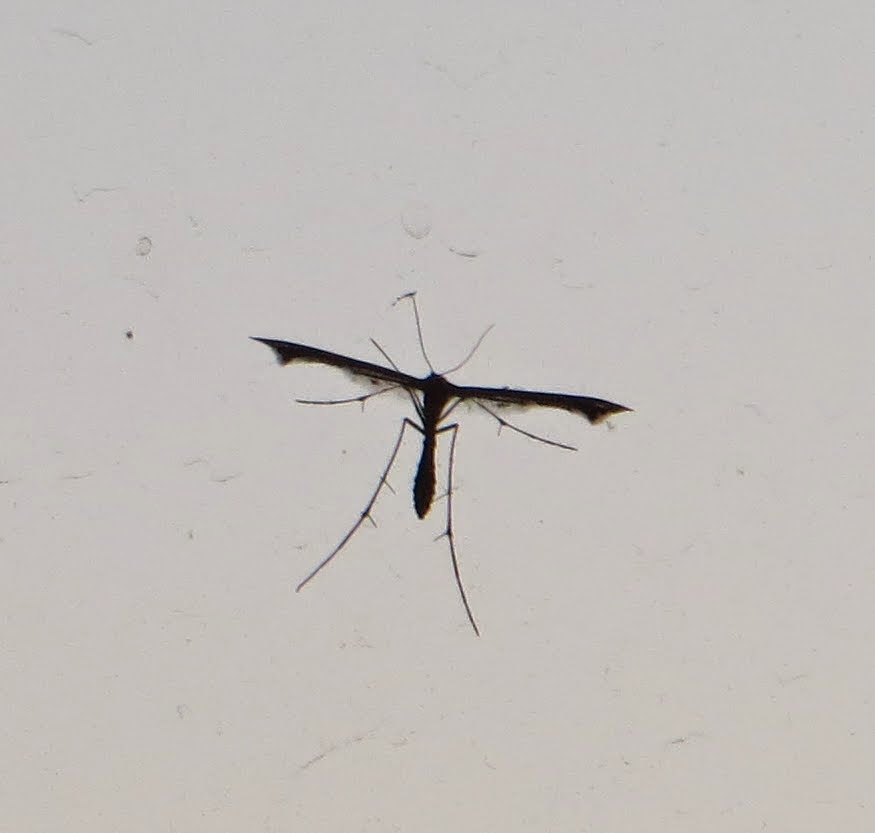.JPG) |
| Artichoke Plume Moth |
Below is a White-lined Sphinx moth (Hyles lineata). They are found throughout the United States, southern Canada, and Mexico. They are pretty big moths with wingspans up to three and a half inches. They are very beautiful and, though it can't be seen in this photo, they have pink hindwings. When flying, they hover at flowers and look a lot like small brown hummingbirds. I almost always see them if I walk around near flowers in the evening.
 |
| White-Lined Sphinx Moth |
Below is a Braconid Wasp (Cotesia species). I don't know the exact species, since there are hundreds of species that look very similar. They are extremely tiny (at most, maybe one-eighth of an inch) and look like little flies. Their larvae are parasites of caterpillars. The one below is a female (it's hard to see, but it has an needle-like ovipositor).
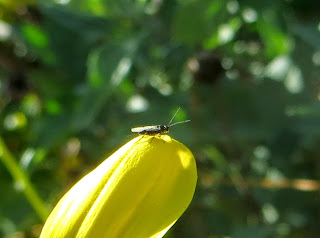 |
| Braconid Wasp |
Below is a Sweat Bee (Halictus
tripartitus). They are a native bee and are smaller than honey bees. They are black and white with somewhat large heads. They are named for their habit of drinking human sweat, probably for the salt.
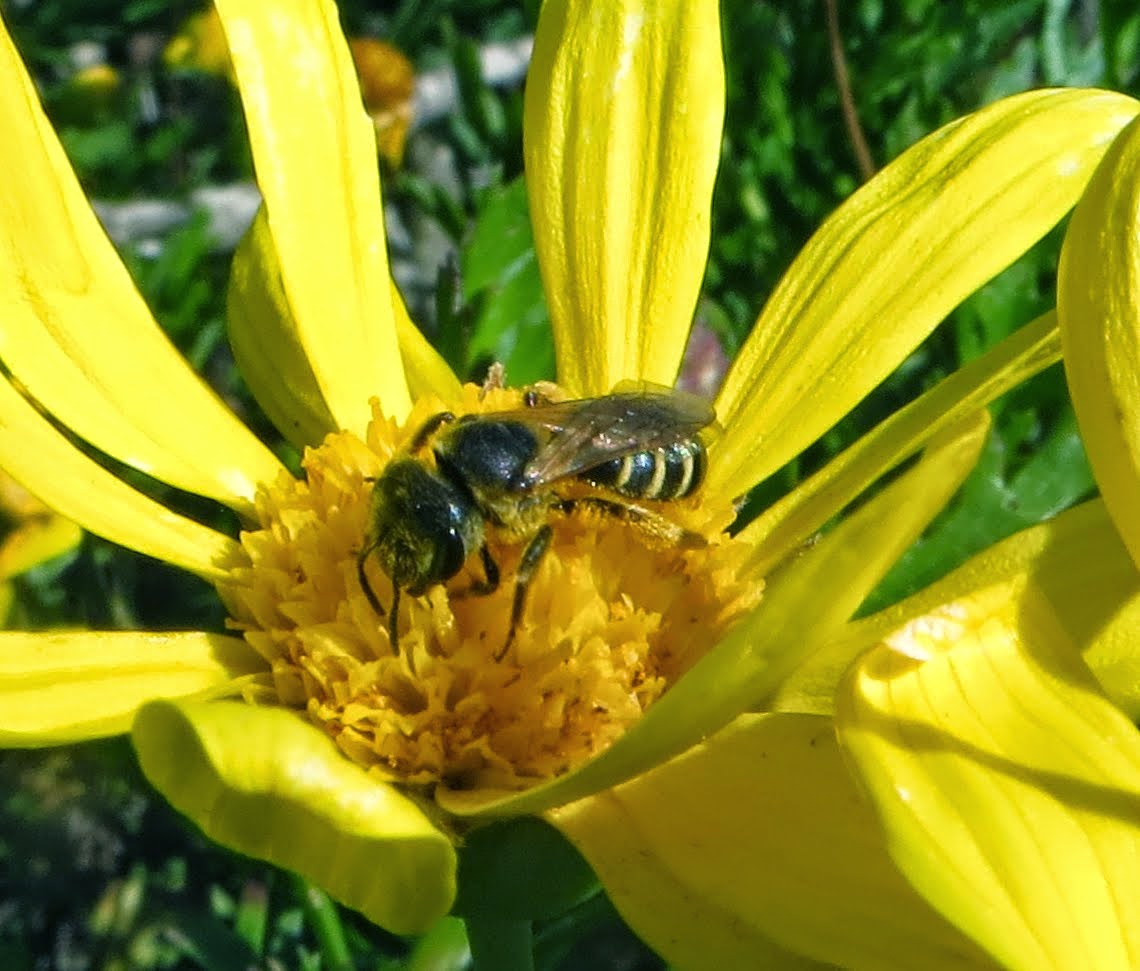 |
| Sweat Bee |
Below is another Sweat Bee of unknown species (there are many, many species of sweat bees). The one below is a particularly tiny species, about the same size as a Braconid Wasp (see above).
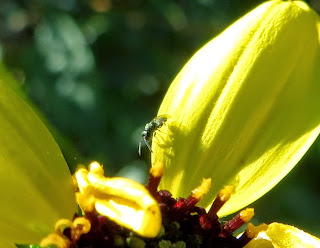 |
| Sweat Bee |
Below is a Honey Bee (Apis mellifera). They were introduced from Europe and are now found in southern Canada and throughout the United States. They, unlike other species of bee, have barbed stingers that get pulled out when they sting, which is why they die soon after.
 |
| Honey Bee |
Below is a Yellow-faced Bumble Bee (Bombus vosnesenskii). They are found in western North America. Like most bumble bees, they nest in the ground, usually in abandoned rodent burrows. They are distinguishable from other bumble bees by their yellow faces, half yellow half black thorax, and mostly black abdomen with one yellow band near the end.
 |
| Yellow-faced Bumble Bee |
Below are California harvester ants (Pogonomyrmex californicus). They are large, native, desert ants found in the southwestern United States. Oddly, I saw these ones in Texas, not California.
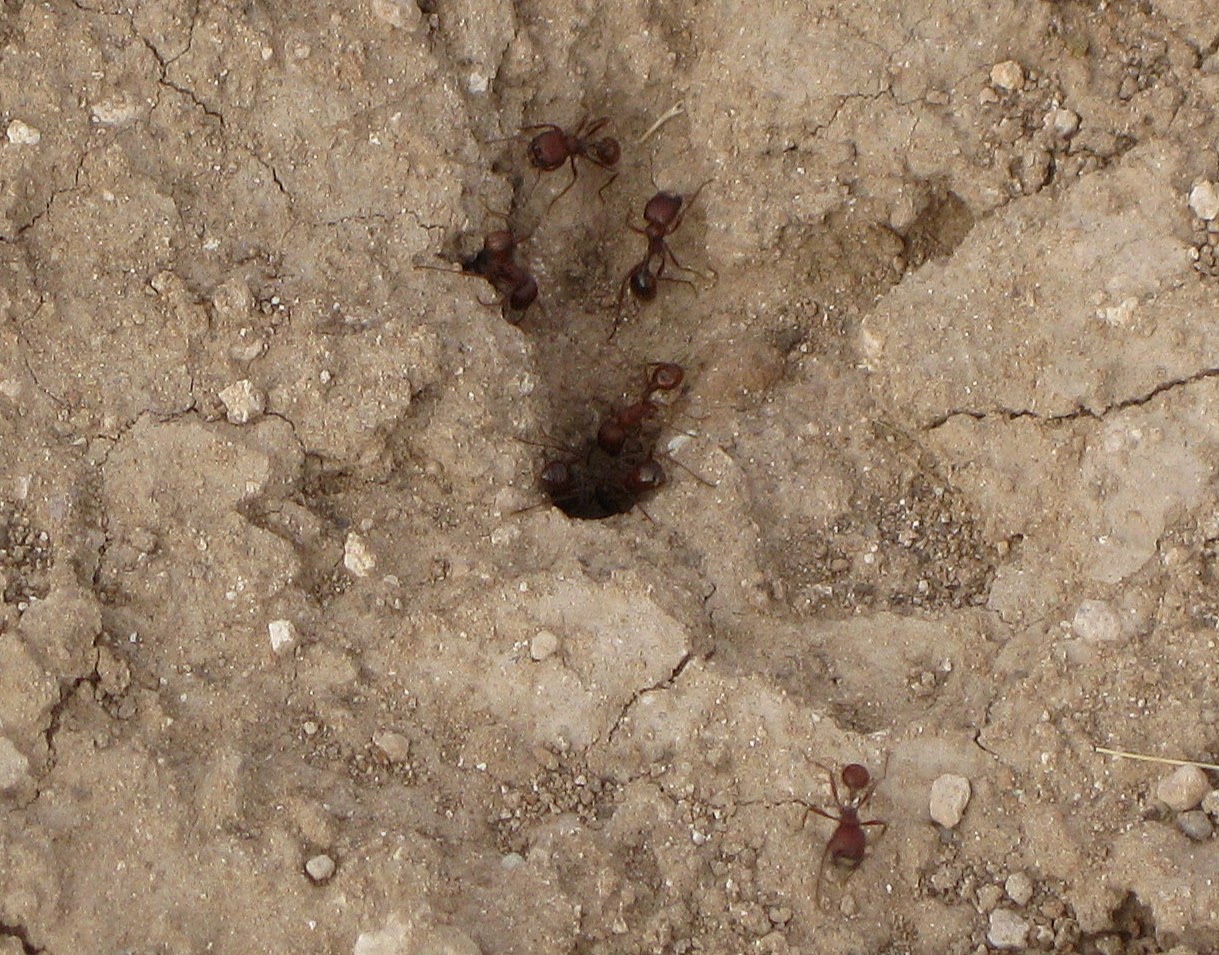 |
| California Harvester Ants |
Below are Argentine ants (Linepithema humile). As their name suggests, Argentine ants are native to South America. They were accidentally imported to the United States and are found throughout the southern United States around urban areas. Unlike many other ants, Argentine ant colonies do not fight with each other, and will actually mix and combine to form supercolonies with multiple queens and nests. They are very aggressive toward other species and have few predators. They also farm aphids for their honeydew.
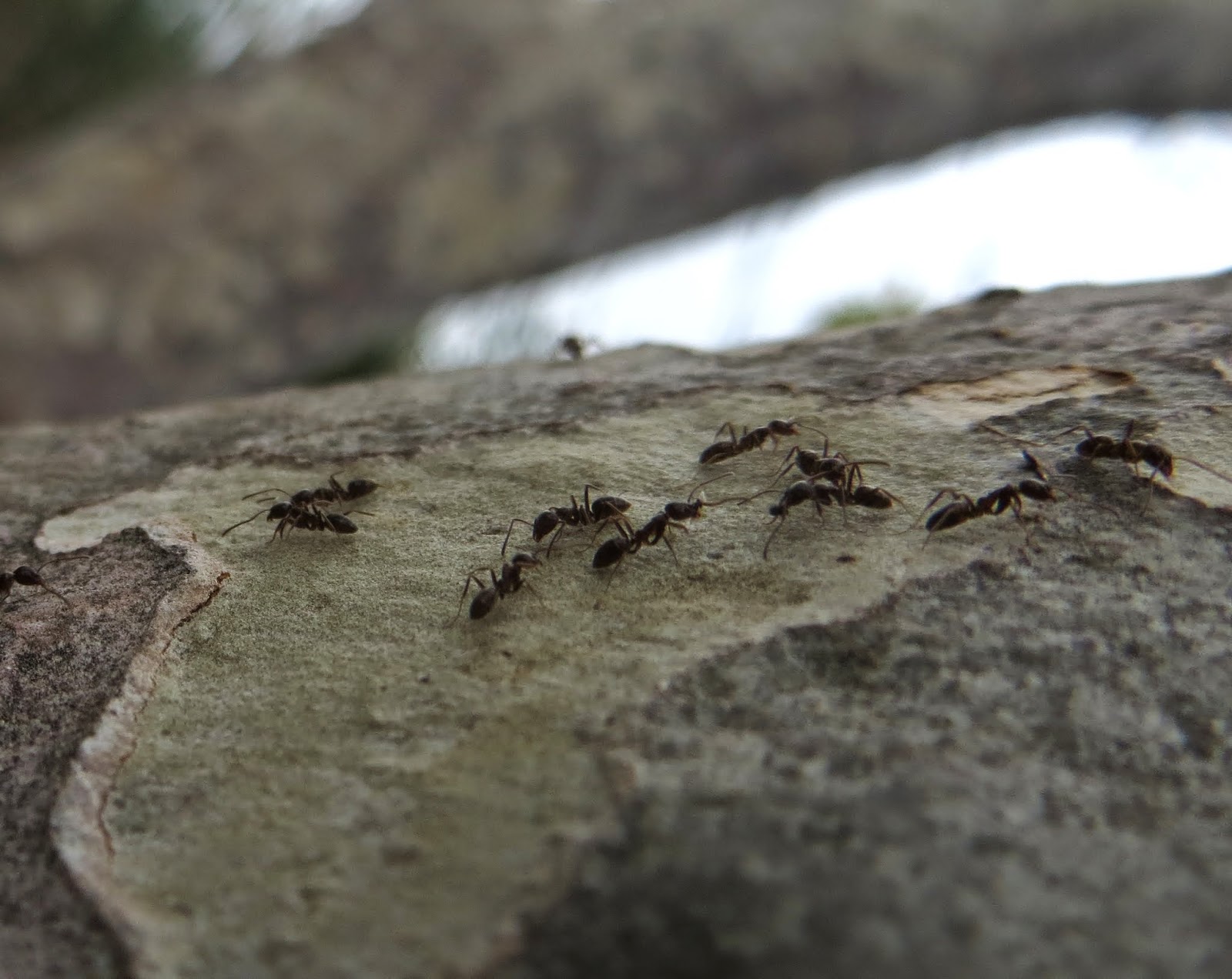 |
| Argentine Ant |
Below is a long-bodied cellar spider (Pholcus phalangioides). They are often called "daddy longlegs spiders" for their resemblance to daddy longlegs, or harvestmen, which are not actually spiders. There is an urban myth that cellar spiders have the most deadly venom of all spiders. However, like most myths, this isn't true. Their venom is not particularly dangerous, and their mouthparts are too small to puncture human skin, anyway. Long-bodied cellar spiders are found throughout North America, often inside buildings.
 |
| Long-bodied Cellar Spider |
Below is a brown widow (Latrodectus geometricus). They are native to Africa, but have now spread throughout the southern United States. Brown widows, unlike black widows, will make their webs out in the open as well as in dark corners. Both males and females are brown with striped legs and a tan-colored hourglass mark under the abdomen (which is usually visible, since they hang upside-down). Males are smaller than the females with longer legs (male black widows are also brown with striped legs, but they have a red hourglass, not tan).
 |
| Brown Widow |
Below is a Southern Black Widow (Latrodectus mactans). Although they are called "southern," they are found throughout North America. Females are almost instantly recognizable by their completely black bodies and red hourglass marks, but males are not so obvious. Males are much smaller and brown, with white lines on their abdomens and a very small red hourglass. Usually, they prefer dark corners, but this one was out in the open in a classroom at high school. It had probably come out at night when the classroom was dark (we found it in the early morning). After it was discovered beside a computer, the teacher safely caught it and released it outside.
 |
| Southern Black Widow |
Below is a European Garden Spider, also known as the Cross Orbweaver (Araneus diadematus). Their second name comes from the fact that the markings on their backs are almost always in the shape of crosses, and their webs are shaped like orbs. They were introduced to North America from Europe and can be found across the United States in both rural and urban environments.
 |
| European Garden Spider |
Below is a yellow garden spider (Argiope aurantia). They are found throughout the United States. They are very large, very beautiful spiders.
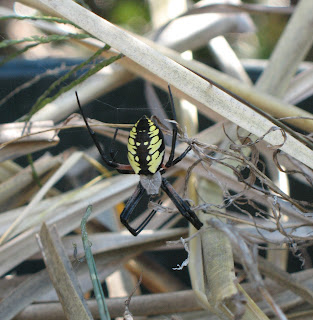 |
| Yellow Garden Spider |
Below is a thin-legged wolf spider (Pardosa sp.). I don't know the exact species (there are about 70, and they all look rather similar). Like most wolf spiders, it was quite large. I found it at high school on the sidewalk. It was lying flat with all of its legs stretched out. Then, suddenly, it raised itself up on its legs, rotated in a circle, looking around, and then ran very quickly to the grass. If you want to look for wolf spiders, try going out at night using a flashlight; their eyes are highly reflective. They're usually very hard to find during the day, as they blend in very well with the ground (unless, of course, they're on a sidewalk).
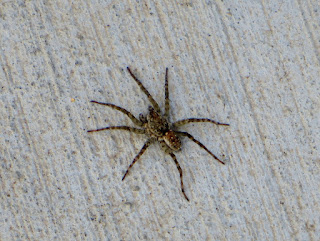 |
| Thin-legged Wolf Spider |
Below is a green lynx spider (Peucetia viridans). They are found in the southern half of the United States. They can be hard to spot; their green color allows them to blend into the green leaves of plants.
 |
| Green Lynx Spider |
Below is a goldenrod crab spider (Misumena vatia). Goldenrod crab spiders are able to change color to match their surroundings. They often hide on flowers to ambush bees and flies.
 |
| Goldenrod Crab Spider |
Below is a Slender Crab Spider (Tibellus sp.). Unlike the spider above, Slender Crab Spiders aren't so crab-shaped. They are somewhat large and have long, skinny legs and skinny, triangle-shaped bodies. They can be found on the ground, where they actively pursue prey (they don't build webs). They can remain very still for long periods of time, though, so they might be hard to spot. I usually see them on the walls in my house. I've never actually seen one move.
 |
| Slender Crab Spider |
Below is a Wind Scorpion (also called Sun Spider, though they aren't spiders). I don't know the species, since there are over one hundred in the United States. They are very quick and eat insects and spiders. They are usually nocturnal. Although they can bite, they are not poisonous. The one below was digging a hole for some reason; maybe for a burrow. It would dig and dig with its front legs, then gather up the loose dirt and push it away from the hole. It seemed very busy and determined.
 |
| Wind Scorpion |

Remarkable photography - glad I discovered your site, Morgane
ReplyDeleteThank you!
Delete